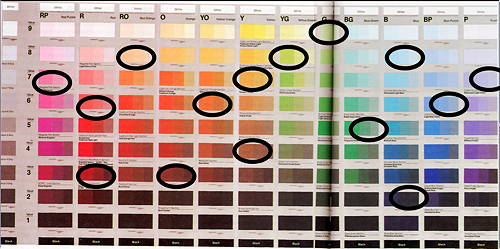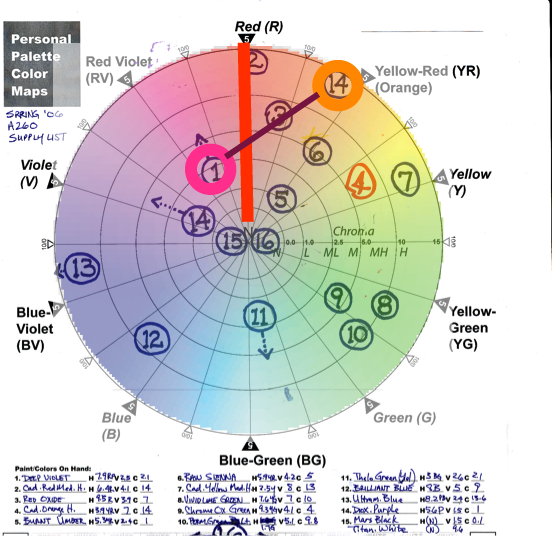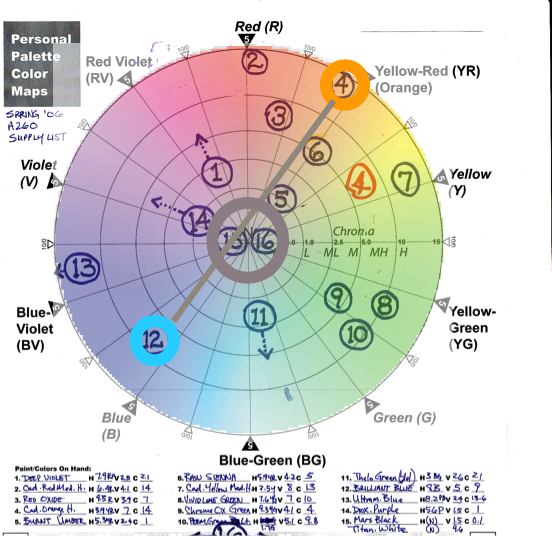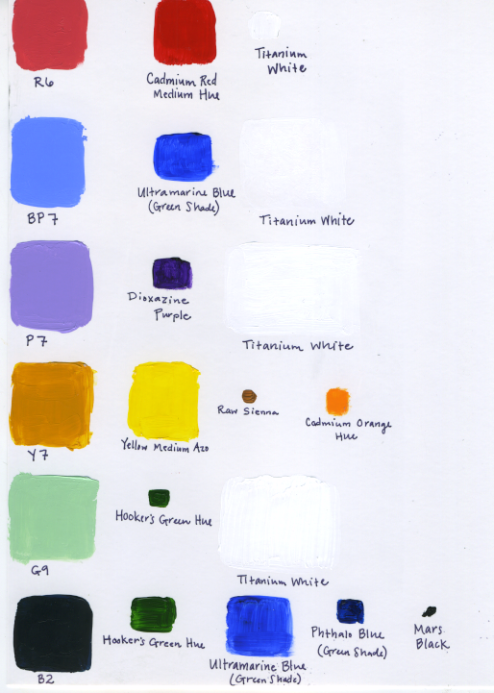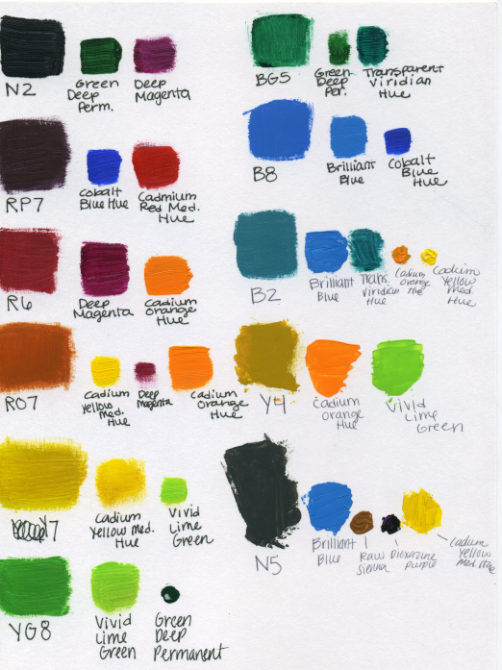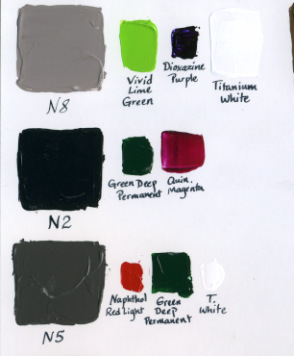Complete your Color Mapping first so that you're clear on your source colors and their relationships.
Assigned Target colors to mix:
— RP7, R6, RO7, O3, YO6, Y7, YG8, G9, BG5, B8, BP7, P7, (see p.78-9, Color 6th ed.)
— B3, R4, Y5 mixed without using primaries
— N2, N5, N8 without black. Twice ...using two different sets of source colors. (that's 6 mixes)
( that's 21 mixes total )For Class 6;
— complete 6 target colors, listed above,
... including P7 without Dioxazene Purple (or anything close to Munsell 5V)...
... and YG8 without Vivid Lime Green (or anything close to Munsell 5YG).
— including one of the primaries mixed without using primaries.
— including one set of neutrals (N2, N5, N8) without using black.
For Class 7:
— complete the remaining color mixes. Turn in all 12 basic color mixes.
— complete all three of the primaries mixed without using primaries.
— complete the second set of neutrals (N2, N5, N8) without using black — use different colors than you used in your first neutral set.
Color Mixing Method: Straight Line Mixing
For each assigned target color:
What does the specified color look like?
Locate a sample of the assigned color on your Liquitex Color Map. (that is, figure out what the assigned color actually looks like.)
Ideally, use the large Liquitex paint-based swatch maps that are in our classroom. If necessary, use the reduced-color-gamut chart that is in your text (Color, 6th Ed., p. 78-79)
The colors specs assigned refer to this chart:
the letters refer to hues (columns),
the numbers refer to rows (values).for instance...
RO 8 = Red Orange at value 8BG 5 = Blue Green at value 5
What do I mix it with?
Study your Personal Coior Map and your Personal Color Wheel.
Look for colors that you own (source colors) that can be used to mix the target color.
Use the the straight-line-mixing techniques (Color, 6th Ed. p.79) for your basic mixing strategy — as presented in class.
Now plan and mix your color. Select likely "parent colors" — 2 straight line, or 3 "Y" colors.
Aim to
A) get the hue correct first, then
B) refine the value, if needed, using white or black.In this assignment, you don't have to bother with chroma — except to try to mix the richest chroma that you can create using the colors you own.
Expect to refine the color mix by adjusting proportions and/or by adding other colors. Work until your mixed color is good match to the colors on the Color Map.
How do I record the results?
Once you have successfully mixed your color:
— Paint a sample on card-stock plates (up to 6 samples/mixes per plate). (target/final color sample should be at least 1” square)
— Label target color (e.g. "RO7", "YG8", "B8", etc.)
— Paint a sample of each source color, showing source colors in approximate proportions needed to mix target color.
— Label/identify source colors (write the paint name next to each e.g. "Cadmium Red Medium Hue", "Titanium White", "Dioxyzene Purple", etc.)Paint your samples on the provided "plates" — the cardstock sheets.
These are usually available in our classroom, on top of the black filing cabinet. (you may paint on either side...though I usually paint on the glossy side.)
You can paint several samples on each plate — up to 6 or so. There is no set format, other than the guidelines noted above.
Primary Color Mixes
We've been told since gradeschool that you can't mix primary color — that you have to buy red, yellow and blue in order to get red, yellow or blue.
Let's debunk that myth.The Straight-Line Mixing strategy is the key. If you understand that, then you'll be able to figure out which colors to use to mix primaries.
Look of your Personal Color Wheel — the graphically inventoried set of colors you own. (you can do this with your Personal Color Map, as well, but you have more relevant information available on the Color Wheel.)
Mixing RED
Note that Red-hued colors lie all along the bold red line on the map.
Thus, according to the straight-line mixing method, we need to find two colors that "cross" that line. That is, if you connect the two colors with a line, that line needs to cross our red-hue line.
These two colors would work:
#1 Deep Violet
#4 Cadmium Orange Hue (here, mislabled as #14...sorry)
These two colors — a Red-Violet and an Orange will mix to a fairly vibrant Red.
Try it!
Neutral Color Mixes
Neutrals — Blacks, Grays and White — can be bought. Blacks and Grays, however, can also be mixed. Many painters prefer to mix their darker neutrals because of the rich character that is possible. Some painters, Claude Monet in particular, refused to have Black on their palettes. Monet always mixed his neutrals (though its rather rare to find pure neutrals in Monet's later works. "He used quite a limited range of colors in his paintings, banishing browns and earth colors from his palette. By 1886, black had also disappeared." *ref* )
Later in the semester you'll work with complement mixed colors more extensively.
Basic Tactic: Identify colors that are complementaries — look for paints on your Personal Color Wheel that lie opposite each other on the color wheel.
Mixing Neutral
According to the straight-line mixing method, we need to find two colors that "cross" the center of the chart — crossing the neutral zone.
These two colors would work:
#12 Brilliant Blue
#4 Cadmium Orange Hue (here, mislabled as #14...sorry)
These two colors — a near-primary Blue, and an Orange will mix to a fairly good neutral.
Try it!
In practice, many pairs of apparent complementaries will produce near-neutrals rather than genuine, ideal, true neutrals. But a few pairs of pigments/colors do a great job. Painters love to find those pairs.
When your complement mixed colors don't quite mix a neutral, the Straight Line Mixing method profides the insighted needed to correct your mix.
Sample Color Mixes
Below are some color mix samples for reference.
Note that each sample provides a sort of visual "recipe" for how to mix a particular color: all necessary "source colors" are illustrated and labeled, and the amount/proportion is conveyed via the size of the source color swatch.
